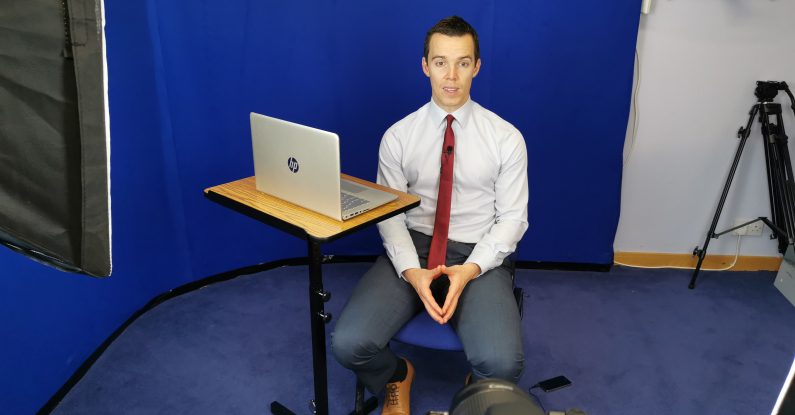
Presenting Remotely training sessions have become a regular occurrence for us.
Why?
Because people realise there’s a way to do it properly.
Businesses recognise that virtual communication is here to stay.
And both want to learn how to get the best out of it.
We believe there are five main areas you can address.
And we’ve got an e-learning course for you too.
Read on for our five tips.
The impact good lighting can have on virtual calls is wildly underestimated.
People sit down, switch on their cameras and begin.
But the ability to control the amount and quality of light can turn a drab shot into a great-looking one.
Natural light from outdoors will always be your best source, so sit in front of a window if you can.
Compare and contrast these images: on the left, with the window behind, and the right, facing the window.
If the lighting in the image on the left looks familar, it's time for a change.
Perhaps, like me, you're unable to face your main window because of your home design.
In that case, buy a ring light.
It'll ensure your entire face is well-lit, rather than horribly backlit.
This one's easy.
Sit or stand so you're in the centre of your shot.
You want to be around 18 to 36 inches away from your camera.
Any further away, and we may struggle to hear you.
Any closer, and we may get a personal look at the pores of your skin.
And if you're seated and on a swivel chair, make sure to plant your feet on the ground.
Nervous energy flows through your body while you present.
And the first virtual casualty is often constant swiveling on the chair.
So make sure to stay centred.
Look at this photo closely.
In particular, look how high Bill's laptop is.
(Yes, the laptop is on an upturned basket.)
This is to ensure his virtual eyeline is level with the camera lens.
Here's a recent example from Bloomberg of how this should look to your audience.
And here's an example of what to avoid.
Where we, the viewer, see too much nostril and ceiling because the eyeline is way above the camera.
You should be able to draw a level, straight line from your eyes to the lens.
Put your laptop or computer under some books to raise its position.
Lower your chair if you can.
Match your eyeline with the lens to give you the perfect virtual shot.
Our rule for backgrounds is simple.
They must avoid being distracting.
We're all dealing with working from home.
But there's things you can do to keep the focus on you.
Rather than on what's going on behind you.
This means tidying up anything in the background, and keeping pets out the room on important calls.
Also, steer clear of virtual backgrounds where you're flying through space.
They're great for family Zoom catch-ups.
Less good when you're giving a project update.
The first four areas I've explored are all about setup.
Things you can do in advance of your call to ensure you look the part.
This fifth area is what turns a good presenter into a great presenter.
It's about your eye contact on virtual calls.
Let me explain.
The majority of people, when presenting virtually, look at the screen while they speak.
This is understandable because in person we'd be making eye contact.
But in the virtual world, it's wrong.
There's only one place you should be looking to build virtual eye contact.
The lens of your camera.
To fully engage your audience remotely, you've got to focus all your attention on that little black circle.
It's difficult, I know.
Particularly when you can see all the faces in your peripheral vision.
But it's the single biggest factor to take your virtual presenting to the next level.
Stick a post-it note or similar next to your webcam ahead of your next call.
It'll remind you to look there when it's your turn to talk.
And when you're listening to others, you can watch the screen again.
I believe we'll be running Presenting Remotely training sessions for years to come.
New businesses will spring up, and long-established ones will need refreshers.
Some media interviews, like the one I did recently on BBC Scotland, will also be done virtually.
So it's vital we know how to do it properly.
If you're yet to feel fully confident with your virtual setup, write to us to arrange your own training session.
Or, if you'd prefer to learn at your own pace in your own time, we've got an affordable e-learning course.
You can buy our Presenting Remotely course on the Pink Elephant Academy.
Add to your skillset, and watch your confidence grow.
Colin Stone is Communications Lead at Pink Elephant.
You can read more about him here.
Photos in Presenting Remotely Training blog by Pink Elephant Communications, Pexels and VMG Studios.
Presenting Remotely Training blog edited by Andrew McFarlan.
2nd September 2021 Featured in: Our courses blogs, Presentation skills training blogs By: Pink Elephant
Some media trainers knock you down…and leave you down. Our media coaches show you how to deal with each knock…and still win through. So you have the presentation skills to perform – with confidence.